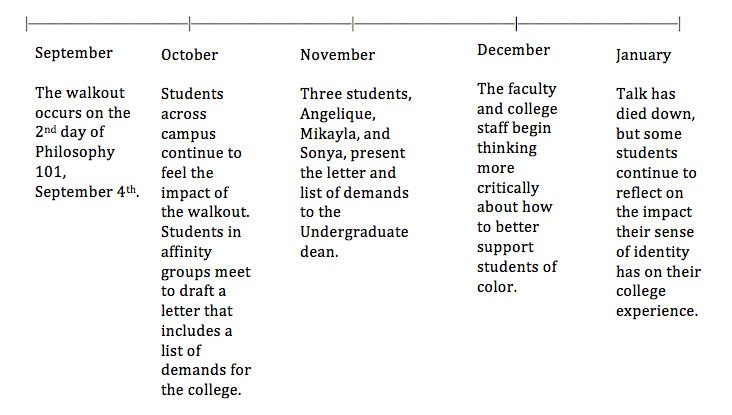Serendip is an independent site partnering with faculty at multiple colleges and universities around the world. Happy exploring!

So much alike
I had a hard time starting this reflection because I feel as though my participation/engagement constantly fluctuated throughout the semester, the whole year really, but definitely more this semester. I think that for the most part I took a lot of steps back this semester, in terms of speaking less and listening more; I found myself not wanting to take ‘leadership roles’ as much as I would have any other time. At times I felt as though I wasn’t putting in as much effort or working as hard as I should have, and it really bothers(ed) me because this is my favorite class of the week and is the one thing I look forward to every week. I think I missed about two of the prep-meetings. The weeks I would miss the meetings, I would feel a little lost that Friday. We put so much thought into every activity, not being there to plan for it makes me nervous because I am not sure which “direction” we aimed to take the conversations; because of this, not being 100% prepared did not scare me that much. Overall, this was a very difficult semester for me; between my mother being injured and my friend going to jail (and all of the in-between), I had way too much going on towards the end of the semester and it was hard for me to focus on my life on campus.

Self-Evaluation: A Series of Critical Love Letters
Here is a link to my self-evaluation: /exchange/book/standing-wall/self-evaluation
As always, it has been a pleasure, and I cannot wait to work with you all again!

Additional Reading and Resources
I have put together this section because so much external reading informed what I ultimately wrote, and I wanted to share those resources with others. The following resources are broken up into three categories: News Articles, Activist Blogs and Archives, and Books by Academics. All of the quotations from the narratives are included in the relevant resource category.
News Articles
In 2007, following an incident of racial insensitivity and ignorance at Bryn Mawr College and a postering campaign on race at Haverford College, several articles in the Bi-College News discussed the way race is experienced within the Bi-Co:
Heller, J. (2007, May 1). Profs Organize Race Discussion at HC – The Bi-College News. Retrieved May 15, 2014, from http://www.biconews.com/2007/05/01/profs-organize-race-discussion-at-hc/
Milne, A. (2007, April 17). Students Call for SGA Treasurer’s Resignation – The Bi-College News. Retrieved May 15, 2014, from
http://www.biconews.com/2007/04/17/students-call-for-sga-treasurers-resignation/
Vasko, L. (2007, May 11). Social Justice in the Bi-Co – The Bi-College News. Retrieved May 15, 2014, from http://www.biconews.com/2007/05/11/social-justice-in-the-bi-co-3/
Then last year (2012-13) protests and discussion occurred surrounding the closing of Perry House at Bryn Mawr. A letter from several students on the closure was featured in the Bi-College News:

a reflection on writing a comic book about writing a paper
This is a reflection on my third English paper for Anne, which took the form of a comic book and was never fully completed. I will be attaching scans of the pieces that had been completed SOON and using this space to outline where the comic will continue to go.
I chose to write a comic book for several reasons. The first reason was that I am interested in experimenting with forms of academic work that diverge from conventional assignments, such as essays and exams. In doing so, I hope to challenge the notion that these conventional assignments are the most adequate methods of measuring student growth and learning inside the classroom. By expanding our understanding of what a “paper” looks like, we can better serve the needs and strengths of diverse learning styles.

Walkout
Forward
Writing about anti-racist activism felt relevant and pressing at a time when my own college, along with many other colleges, is in the midst of discussions about increasingly visible diversity on campus. Mount Holyoke has recently dealt with a publicized instance of racism by their campus police against a student of color,[1] and in response students of color have launched a campaign called “#mohonest” [2]. Wesleyan is now in the midst of protests regarding the gradual loss of faculty from their African American Studies department[3]. Students at countless schools are launching “#I too Am…” campaigns, inspired by Harvard students, to highlight the membership of students of color in their college communities[4]. I wanted to write this piece to explore the ways institutional racism impacts people on traditionally white college campuses in different ways. I also wanted to look at the way anti-racist activism can become the center of one’s experience in a space, or can be a marginal or even completely absent part of one’s experience.




